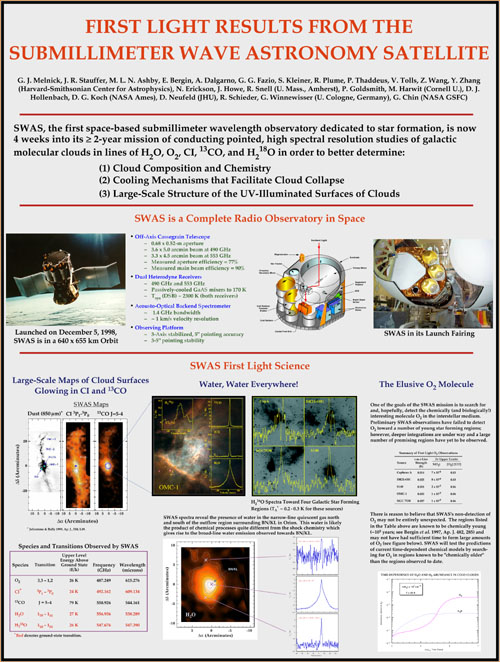|
First Light Results from the Submillimeter Wave Astronomy Satellite
Melnick, G. J., Stauffer, J. R., Ashby, M., Bergin, E., Dalgarno, A.,
Fazio, G. G., Kleiner, S., Plume, R., Thaddeus, P., Tolls, V.,
Wang, Z., Zhang, Y., Erickson, N., Howe, J., Snell, R., Goldsmith, P.,
Harwit, M., Hollenbach, D. J., Koch, D. G., Neufeld, D., Schieder, R.,
Winnewisser, G., Chin, G.
The Submillimeter Wave Astronomy Satellite (SWAS) is a NASA, Small Explorer
class mission dedicated to the study of star formation and interstellar
chemistry. During its planned 2 year mission lifetime, SWAS will
simultaneously survey emission from the H2O
11,0-10,1 (557 GHz), 13CO J = 5-4
(551 GHz), O2 (J,N) = (3,3)-(2,2) (487 GHz), and [CI]
(3P1-3P0) (492 GHz)
lines in Galactic and extragalactic objects. We also have the capability to
tune for the H218O 11,0-10,1
(548 GHz) line. SWAS employs two independent Schottky barrier diode mixers
coupled to a 54 x 68 cm off-axis Cassegrain antenna with an aggregate surface
error less than 11 micrometers (rms). The backend is a 1.4 GHz bandwidth
acousto-optical spectrometer which yields a velocity resolution of less than
1 km s-1. Our mission objectives are to detect water and molecular
oxygen in dense (nH2 > 103 cm-3)
molecular glouds, or set upper limits to the abundances of these species
(3 x 10-6 for H2O (relative to H2) and
2 x 10-6 for O2). Comparison with the recent ISO
detections of water emission at higher frequencies from shocked molecular
gas will allow us to accurately determine the water abundances in these
regions. In addition, we will use the large beamsize of SWAS (3.2' x 4.0' at
551 GHz and 3.6' x 4.5' at 492 GHz) to obtain large-area ( ~ 1o x
1o ) maps of giant and dark clouds in the 13CO and
[CI] lines. To achieve these goals, SWAS will orbit at an altitude of
600 km. This altitude places SWAS above the water and oxygen inherent in the
Earth's atmosphere and allows us to passively cool the receiver to ~170 K.
The lack of cryogens awards us the possibility to extend the mission
beyond the planned two year lifetime. SWAS is scheduled for launch on
December 2nd (1998) aboard a Pegasus XL rocket. The first science data will
be received approximately ten days after launch. If all goes according to
schedule, we will present exciting new data from the first few days of the
SWAS mission.

[BACK]
|
